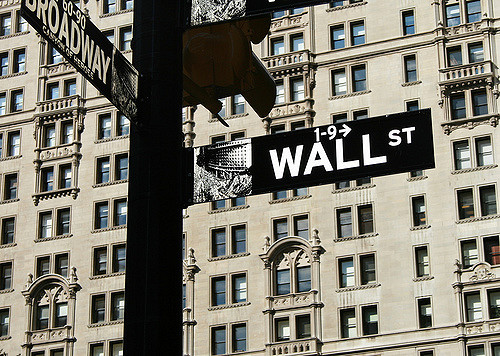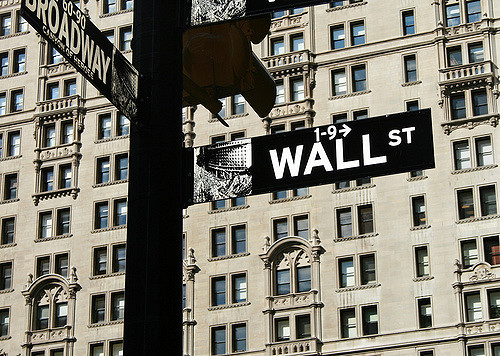
Esteban Chiner via flickr
Losses in Goldman Sachs’ trading division are infrequent. However, recently they put an end to a series of excellent results of the largest American bank and exposed one of the financial industry’s leaders to difficulties. Net profit for the first quarter amounted to 2.26 billion dollars, or $ 5.15 per share. Revenues slightly exceeded 8 billion.
All three indicators have grown during the last year, but were worse than Wall Street’s forecasts. There is a simple reason for this: a 2.4% drop in revenues from operations in financial markets, significantly behind those of competitors.
After the financial crisis, the bank carried out a large business reorganization, reduced risks, reoriented to the consumer and expanded lending. However, the unpredictable and tough business of trading stocks, bonds and commodities is still critically important for Goldman Sachs.
Of course, one weak quarter mean nothing. Investors still consider Goldman Sachs one of the strongest players on the market. I quarter of 2016 also proved unsuccessful, but then the situation improved. This time, however, the situation is aggravated by permutations in the bank’s management.
Gary Kohn, Deputy General Director of Lloyd Blankfein and the second person in the company, in December went to work in the White House. He was replaced by new top managers. Martin Chavez will take the post of CFO at the end of this month. At his first press conference for investors, he explained the failure: "We were weakly oriented in the market. There is always room for improvement and growth, but one quarter does not determine the destiny of the whole unit. "
On Tuesday, Goldman shares fell 4.7%. The bank made a major contribution to growth of the Dow Jones Industrial Average after the victory of Donald Trump. However, Goldman shares are the worst in the index this year. Investors are concerned about reforms proposed by the US president.
Goldman’s return on equity, a popular measure of profitability, in the I quarter was 11.4%. Excluding tax adjustments, it would have been reduced to 8.9%. This is below the theoretical cost of the bank's capital (about 10%) and is a rare occurrence for Goldman Sachs. Investors expected better results, in part because the US Federal Reserve twice raised interest rates in recent months.
This should have had a positive effect on the trading unit’s revenue, as number of bets on further development of monetary policy and the demand for related products increased. However, Goldman did not receive the expected benefits. Its proceeds from bond trading for the year remained virtually unchanged, while J.P. Morgan had the indicators grown by 17%, Citigroup - by 19%, and Bank of America - by 29%.
Chavez blamed low market volatility, which limits trading opportunities. For example, oil prices are showing the greatest stability over the last two-odd years in 2017. This greatly hinders Goldman, since the bank specializes in commodity trading.
In addition, Goldman is far behind its competitors in other areas. Bank of America showed excellent results in corporate bonds trading, and Goldman's profit declined sharply. The difference in revenue from trade in this segment exceeded $ 1 billion - the largest gap between the two companies in history.
The investment banking division of Goldman advises on mergers, acquisitions and fundraising. In the first quarter, its revenue jumped by 16% thanks to large number of IPO and secondary placements. The company managed to protect its market share from Morgan Stanley and kept the first place in terms of revenue in this segment. Yet, there are a number of alarming signs. Compared to the previous year, revenues decreased by 1.9%, and the number of planned transactions fell.
Even fast-growing segments of business could not compensate for the decline in the main trading unit. After the crisis, the company has mastered new, more stable and predictable directions, such as consumer lending and asset management. For example, revenue in the asset management division, working with pension funds, wealthy families and other large customers, grew by 12% over the year.
source: nytimes.com
All three indicators have grown during the last year, but were worse than Wall Street’s forecasts. There is a simple reason for this: a 2.4% drop in revenues from operations in financial markets, significantly behind those of competitors.
After the financial crisis, the bank carried out a large business reorganization, reduced risks, reoriented to the consumer and expanded lending. However, the unpredictable and tough business of trading stocks, bonds and commodities is still critically important for Goldman Sachs.
Of course, one weak quarter mean nothing. Investors still consider Goldman Sachs one of the strongest players on the market. I quarter of 2016 also proved unsuccessful, but then the situation improved. This time, however, the situation is aggravated by permutations in the bank’s management.
Gary Kohn, Deputy General Director of Lloyd Blankfein and the second person in the company, in December went to work in the White House. He was replaced by new top managers. Martin Chavez will take the post of CFO at the end of this month. At his first press conference for investors, he explained the failure: "We were weakly oriented in the market. There is always room for improvement and growth, but one quarter does not determine the destiny of the whole unit. "
On Tuesday, Goldman shares fell 4.7%. The bank made a major contribution to growth of the Dow Jones Industrial Average after the victory of Donald Trump. However, Goldman shares are the worst in the index this year. Investors are concerned about reforms proposed by the US president.
Goldman’s return on equity, a popular measure of profitability, in the I quarter was 11.4%. Excluding tax adjustments, it would have been reduced to 8.9%. This is below the theoretical cost of the bank's capital (about 10%) and is a rare occurrence for Goldman Sachs. Investors expected better results, in part because the US Federal Reserve twice raised interest rates in recent months.
This should have had a positive effect on the trading unit’s revenue, as number of bets on further development of monetary policy and the demand for related products increased. However, Goldman did not receive the expected benefits. Its proceeds from bond trading for the year remained virtually unchanged, while J.P. Morgan had the indicators grown by 17%, Citigroup - by 19%, and Bank of America - by 29%.
Chavez blamed low market volatility, which limits trading opportunities. For example, oil prices are showing the greatest stability over the last two-odd years in 2017. This greatly hinders Goldman, since the bank specializes in commodity trading.
In addition, Goldman is far behind its competitors in other areas. Bank of America showed excellent results in corporate bonds trading, and Goldman's profit declined sharply. The difference in revenue from trade in this segment exceeded $ 1 billion - the largest gap between the two companies in history.
The investment banking division of Goldman advises on mergers, acquisitions and fundraising. In the first quarter, its revenue jumped by 16% thanks to large number of IPO and secondary placements. The company managed to protect its market share from Morgan Stanley and kept the first place in terms of revenue in this segment. Yet, there are a number of alarming signs. Compared to the previous year, revenues decreased by 1.9%, and the number of planned transactions fell.
Even fast-growing segments of business could not compensate for the decline in the main trading unit. After the crisis, the company has mastered new, more stable and predictable directions, such as consumer lending and asset management. For example, revenue in the asset management division, working with pension funds, wealthy families and other large customers, grew by 12% over the year.
source: nytimes.com





